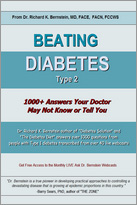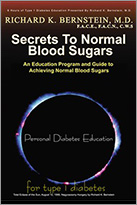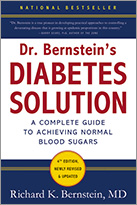Many of the symptoms of hypoglycemia are actually effects of the hormone epinephrine (which you may know as adrenaline). If you do not have the problems listed in the section “Hypoglycemia Unawareness” on page 340, your adrenal glands will respond to hypoglycemia by producing epinephrine. Epinephrine, like glucagon, signals the liver to convert stored glycogen to glucose. It is epinephrine that brings about such symptoms as rapid heart rate, tremors, pallor, and so on. (Beta blocker medications can interfere with the ability of epinephrine to cause these symptoms.)
Epinephrine has a half-life in the blood of about 1 hour. This means that an hour after your blood sugar comes back to target, about half the epinephrine you made is still in the bloodstream. This can cause a persistence of symptoms, even if your blood sugar is normal. Thus, if you took some glucose tablets an hour ago and still feel symptomatic, check your blood sugar again. If it’s on target, try to control the temptation to eat more. If your blood sugar is still low, more tablets are warranted.
COPING WITH THE SEVERE HUNGER OFTEN CAUSED BY HYPOGLYCEMIA
Mild to moderate hypoglycemia can cause severe hunger and an associated panic. The drive to eat or drink large amounts of sweet foods can be almost uncontrollable. New patients, before starting our regimen, have told me stories of eating an entire pie, a jar of peanut butter, a quart of ice cream, or drinking a quart of orange juice in response to hypoglycemia. Before I stumbled onto blood sugar self-monitoring and learned how to use glucose tablets, I did much the same. The eventual outcome, of course, was extremely high blood sugar several hours later.
Since the effects of glucose tablets are so predictable, the panic element has vanished for me and for most of my patients.
Unfortunately, rapid correction of blood sugar does not always correct the hunger. This may be somehow related to the long half-life of epinephrine and the persistence of symptoms even after restoration of normal blood sugars. My patients and I have successfully coped with this problem in a very simple fashion. You can try the same trick we use.
First, consume the appropriate number of glucose tablets.
If overwhelming hunger persists, consider what might satisfy it.
Typical options include a full meal (such as another lunch or supper), half a meal, or a quarter of a meal. A full meal means exactly the amounts of carbohydrates and protein that you would ordinarily eat at that meal. Half a meal means exactly half the protein and half the carbohydrate.
Even if your blood sugar has not yet come back to target, since you know you have consumed the proper amount of glucose to eventually bring it back, you can confidently inject the amount of insulin or swallow the dose of the OHA that you normally use to cover that meal. For half a meal, take half the dose; for a quarter of a meal, take one quarter the dose.
Don’t frustrate yourself by waiting the usual 45 minutes or so after injecting regular insulin, or the 20 minutes after injecting lispro (or aspart or glulisine), or the 60–120 minutes after taking an OHA. Just inject and eat. An extra meal now and then won’t make you fatter or cause harm. Since you’re eating within the controlled boundaries of your meal plan and not gorging on sugars or unlimited amounts of food, you’re still abiding by the Laws of Small Numbers.
If you know how much insulin or OHA you usually take to cover a certain snack, you might have the snack instead of the meal.
HOW FAMILY AND FRIENDS CAN HELP YOU CATCH A HYPOGLYCEMIC EPISODE WITHOUT MUTUAL ANTAGONISM
Two of the most common effects of hypoglycemia can make the job of helping you difficult and unpleasant. These effects are irritable, nasty behavior and failure to recognize your own symptoms. At my first interview with many new patients and their families, instances of violence during hypoglycemic episodes are commonly reported. The most common scenario I hear goes like this: “Whenever I see that he’s low, I hand him a glass of orange juice and tell him to drink it, but he throws the juice at me. Sometimes he throws the glass too.” Such stories come as no surprise to me because as a teenager I used to throw
the orange juice at my mother, and when I was first married, I did the same to my wife. Why does this happen, and how can we prevent such situations?
First, it’s important to try to understand what’s going on in the minds of you and the family member or partner during a bout with hypoglycemia. The cognitive difficulties that accompany severe hypoglycemia can make the slightest frustration or irritation overwhelming. Your low blood sugar may cause you to act bizarrely, as if intoxicated—and in a sense, you are intoxicated. Because your thinking is impaired, you may be totally unaware that your blood sugar is low. The similarity to drunkenness is not a coincidence, since the higher cognitive centers of the brain, which control rational behavior, are impaired in both cases.
You probably have learned that high blood sugars are to be avoided, and at some level, you remember this, perhaps even cling to it, despite your hypoglycemia. If someone tries to cajole you into eating something sweet, you may decide that it’s the other person who’s irrational. This is especially true if the other person has done the same thing in the past, when blood sugars were actually normal or even high. In “self-protection” against the supposed irrational attempt to get you to
eat something sweet, you instinctively may become violent. Most commonly, this occurs if an attempt is made to put food or drink in your mouth. You might view this as an “attack.” In less rational moments, you may even decide, since you know that high blood sugars are harmful, that your spouse or relative is trying to kill you.The helping relative, usually a spouse or parent, may be terrified to see such strange behavior. If your loved one has been through many such encounters, he or she may, for self-protection, keep candies or other sweets around the house in the hopes that you will eat them and thus avoid such situations. The fear can be exacerbated if your loved one has seen you unconscious from hypoglycemia, or is merely aware
that hypoglycemia can cause dire consequences.
On other occasions, when your blood sugar wasn’t really low, your loved one may have erroneously asked you to eat something sweet. Such erroneous diagnoses are especially common during family squabbles. The spouse or parent may feel that “his blood sugar is low, and that’s why he’s yelling at me.” Your loved one would rather play it safe and give you something sweet, even if your blood sugar isn’t low.
There is a solution to this apparent dilemma. First of all, both parties must recognize that, as a rule, about half the time that the relative suspects hypoglycemia, you do not have a low blood sugar; the other half of the time, blood sugar is indeed low.
No one has ever contradicted me when I’ve made this point.
Encouraging a diabetic to eat sweets when hypoglycemia is suspected, despite conventional teaching, does as much harm as it does good. A better approach would be for the loved one to say, “I’m worried that your blood sugar may be low. Please check it and let me know the result so that I’ll feel less anxious.” As a patient, you should realize that living with a diabetic can often be as much or more of a strain than having diabetes. You, the diabetic, owe some consideration to the needs of your loved ones. Try to look upon the request to check your blood sugar not as an intrusion but as your obligation to relieve someone else’s fear. With this obligation in mind, you should automatically check your blood sugar if asked, just to make the other person feel better.
It doesn’t matter whether your blood sugar is low or normal. If your blood sugar is low, you can correct it and find out why. If it’s normal, then you probably will have diffused the tension of the situation, and now you’ll be able to get back to whatever you were doing, unworried that blood sugar is off target. When you look at blood sugar as something like a clock that you can set—and reset—you take some of the mystery out of it, and can diminish the emotion involved.
If you’re without your meter, take enough glucose tablets to raise your blood sugar about 60 mg/dl—again to make the other person feel better. This is the least you can do for someone who may worry about you every day.
Believe it or not, this simple approach has worked for me and for many of my patients. As I’ve said previously, I went through this with my parents and have gone through it with my wife. Spouses report that it relieves them of a great burden. Some wives have even cried when expressing their gratitude.




